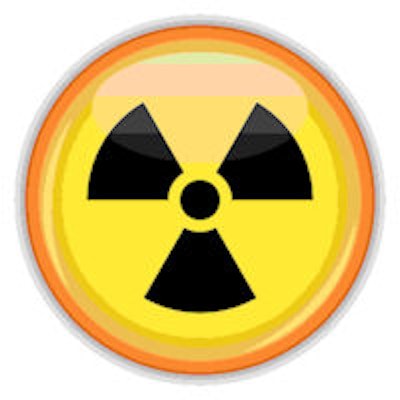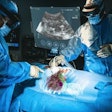
A radiation patient exposure tracking system has cleared technical and political hurdles to become a useful tool for monitoring a patient's exposure history and reducing the chance of overexposure to radiation. The system will eventually be operational throughout Europe, and perhaps beyond, according to a new article in Radiation Protection Dosimetry.
The system allows patients to provide access to their individual dose data to practices they choose to provide it to, explained authors Dr. Madan Rehani and Theocharis Berris from the International Atomic Energy Agency (IAEA) in Vienna. The paper discusses the organization's Smart Card/SmartRadTrack project, offering templates for implementing dose tracking at the level of the single hospital, the multipractice environment via a PACS network, as well as nationally and internationally.
 Madan Rehani, PhD, led the IAEA study.
Madan Rehani, PhD, led the IAEA study.
Even countries with fewer medical resources can participate using a manual system to get things started, the team wrote. Critical elements include the patient identifier, the source of some political pushback, and dose information from the scanning device, typically the DICOM file. Several other problems, mostly technical, remain to be solved.
"The IAEA initiated the Smart Card/SmartRadTrack project and it is gratifying that within the space of a few years, technological developments have been tremendous in making exposure, and even dose tracking, possible," wrote Rehani and Berris (Radiat Prot Dosimetry, 22 July 2013).
"What is pleasing is that PACS technology has already matured, and dependence on electronic health records (EHR) has been reduced," Rehani explained in an email to AuntMinnieEurope.com. "In 2009 when I published the first paper on this subject, my feeling was that EHR would be the determining factor for tracking, but PACS technology has moved much faster to make tracking feasible, reducing the dependence on EHR."
With patient doses often reaching into the tens of mSv, and lifelong occupational dose standards being exceeded routinely, new approaches are needed to protect the individual patient and keep track of radiation exposure, the authors wrote. "The radiation protection approaches that are based on the collective dose to population need to be shifted to protection of an individual patient," they wrote. "When the issue of protection of the individual arises, accounting for exposure history becomes necessary."
Tracking helps patients
However it is accomplished, exposure tracking serves to strengthen the process of justifying and then optimizing radiology exams, and as a result does a better job of protecting the patient, the authors wrote. As the process is implemented, tracking exams is the first priority, and tracking dose is second.
Progress is accelerating now, thanks to technologies that weren't available when the project was launched in 2006. But a key requirement for making the system usable beyond a facility or network is the availability of permanent patient identifiers, which remains a roadblock. In a recent survey, 81% of the 40 countries that participated in the project said they have patient identifiers available; however, only 55% currently use them in their EHR.
"The most important barrier is the use of permanent identifier for patients," Rahani told AuntMinnieEurope.com. "The second barrier comes from the [limited] extent of coverage of PACS networks."
The paper outlined a series of templates with the aim of enabling as many facilities as possible to participate in exposure tracking.
Individual practices/hospitals
Most vendors provide the means of tracking patient exposure history through the institution's PACS, the authors wrote. In addition to the PACS network connecting imaging systems, systems require a unique and permanent identifier for each patient that is used whenever the patient undergoes an imaging exam. Also needed are DICOM or other type of standard and structured dose reports containing standardized dose quantities.
"Practices should anticipate that larger-scale integration (e.g. between practices or hospitals, practices outside of the local health care network) is desirable and may even become mandatory in the coming years," the team wrote.
Multipractice networks
For now, multipractice implementation exists in only a few countries such as Finland, where a network of 35 hospitals is linked. In this comprehensive network, just 1% to 5% of imaging studies are conducted outside of the patient's network.
Multi-institutional connectivity requires several elements in addition to those needed for a single practice. Requirements include a patient identifier common to every facility in the network, and a linked PACS network. Typically, such networks also allow access to images and other data from outside networks with the assistance of the PACS administrator. For dose tracking, communication of structured dose report files must be available, the authors wrote.
Many vendors use DICOM standard and structured dose reports with standardized dose quantities, and the structured dose reports are sent along with images files of patients for modalities such as CT. Dose information is also becoming available for fluoroscopy and radiography, the authors wrote.
Central Europe and PACS
Tracking exposure at the national level is a matter of extending the principles of the county and state level to the nation, according to Rehani and Berris. It is certainly feasible with current technologies, but the political will to achieve this goal must also be present, they wrote. Many European countries are planning, or at some state of implementing, nationwide PACS networks.
Estonia, for example, already has a nationwide PACS network serving its population of 1.34 million that can track any patient's radiation exposure including from nuclear medicine exams. Other countries are advancing, but need help to fully implement the systems, Rehani stated.
"In many Central European countries where permanent identifier for person is routinely used for medical records, tracking has already become a reality within the PACS network," Rehani wrote. "Having a few dozen hospitals connected by PACS is becoming common in many Central European countries." Still, he added, "In many countries while tracking is feasible based on existing technology, there is lack of documentation of its use. And many Eastern European countries "are confronted with lack of financial resources to achieve PACS network," Rehani wrote.
The sheer size of the endeavor argues for national commitments to complete it. Different practice settings require the cooperation of many different international players, the study team wrote.
"Political actions are needed in having and using patient ID and establishing network of PACS to cover more and more imaging facilities," Rehani wrote. National PACS networks are the preferred vehicle now, despite the limited funds available to implement them, he added.
Guaranteeing data security is another top priority for national networks. Part of data security is ensuring that personnel are limited to the information they need to carry out their specific jobs. Establishing and using national patient identifiers can also be a sticking point. The most developed centers in each country can work as national hubs to disseminate information to other facilities, the authors advised.
Current challenges in radiation dose tracking include:
- Available resources
- Relevant population
- Clinical setting
- Dose and risk assessment
- Ownership and purpose of dose interpretation
- Patient privacy
"Lack of use of unique patient identifiers is a significant barrier in many countries that undermines dose tracking," the group wrote. Most countries are capable of tracking only by patient name, which is inefficient. And birthdate, not the commonly used patient age, is a requirement for operational tracking. The use of unique patient identifiers also eliminates the need for patients to remember important information about their medical histories.
The unique patient number is like a credit card in that it must not be provided to anyone outside the care provider network, wrote Rehani. Their use with multiple medical providers can spark questions about privacy, but patients seem increasingly willing to give up some small measure of privacy for the health benefits they gain in exchange.
The many benefits of dose tracking include:
- Minimizing exposure and cumulative dose
- Controlling costs
- Optimizing imaging protocols
- Help in choosing facilities and providers
- Improvement in justification, decision support, and feedback for imaging
- Support for continuous review of reference radiation levels
- Improvement of patient health and safety
- Improving the state's ability to monitor and improve imaging safety
- The ability to include patient-specific radiation metrics into research studies, tracking the comparative effectiveness of approaches, and providing a quantitative basis for the development of best practices
International Implementation
The electronic health record is paramount in the successful implementation internationally, as "integration at the level of radiology alone may be difficult ... and unsupportable," Rehani and Berris wrote. The European Commission established standards for European eHealth interoperability in 2008, and is currently supporting a series of pilot projects among member states to demonstrate that large-scale integration is possible, with implementation of solutions for all of Europe to be rolled out later.
"The initiative will enable easy and fast access to a citizen's EHR or a targeted extract from it (such as patient summary or emergency data), from anywhere in Europe, at any time," the study team wrote. Transmission of health records internationally will allow the tracking of radiological procedures and dose throughout the network.
The EU's Information and Communication Technologies (ICT) Policy Support Program (ICT PSP) has an overall budget of 140 million euros ($185 million U.S.) for 2013, the authors stated. The EU and the U.S. have signed a Memorandum of Understanding to promote a common approach on the interoperability of electronic health records and educational programs for IT and health professionals.
Implementation in less developed countries
For countries that lack access to PACS and electronic health records, implementation of a "radiation passport" similar to a vaccination card, could be the first step toward implementation radiation monitoring program, the group wrote. Samples from the Image Gently program and the U.S. Food and Drug Administration (FDA) offer sample cards for the entry of each exam -- not the radiation dose -- and that is enough for such a program, the group wrote.
"It can be very good so long as it is maintained and used; however, the record remains only with the patient, not with the healthcare system, and it is highly dependent upon the patient and the healthcare provider," Rehani and Berris wrote. The cards can also serve as a vehicle for informing patients that they should not forego prescribed imaging exams for fear of radiation, and that they should not insist on an x-ray if the doctor considers it unnecessary.
The cards can also help communicate the limitations of dose exposure guidance in that physicians cannot provide the exact exposure levels. They allow patients to inquire about dose quality control programs, and patient protection measures such as the use of radiation shields. Whether or not patients are willing to use manual cards, however, remains unknown.
"While there is interest, we do not have evidence of compliance," Rehani wrote in an email. "We are going to have a meeting at the IAEA 23 to 25 September to get further information on these and decide further actions."
Technical Issues
Recently a prototype "Smart Card" system was developed that gives the patient the ability to allow a healthcare facility to access his patient information. A key current challenge is determining the format of radiation dose information that will be included on them, the authors wrote.
A key challenge is the format used for dose reporting. For CT, volume CT dose index (CTDIvol), and dose length product (DLP) are used to estimate effective dose, and other factors can be incorporated to arrive at effective dose. But fluoroscopy uses different standards: dose area product (DAP), kerma area product (KAP), cumulative air kerma (CAK), and entrance surface dose (ESD), and like the most common CT measures, do not account for patient size. Radiography usually relies on ESD or effective dose, and mammography uses mean glandular dose (MGD) as a dose metric.
"It would be highly desirable if manufacturers developed machines keeping in mind that capabilities of lifetime exposure tracking are very important," Rehani and Berris wrote. They also noted a need to shift from machine output-based dose to patient dose taking into account patient's cross section or weight. Figures must be made available to look at doses applied retrospectively as well, they noted. "This means that data must be kept in a form of structured dose reports that may be communicated easily through PACS systems," they stated.
The problem of tracking dose data among vendors has been largely solved, the authors concluded. "However, challenges remain with patient identification number that requires political handling and nuclear medicine exposures that require professionals and industry to contribute," they wrote.



















